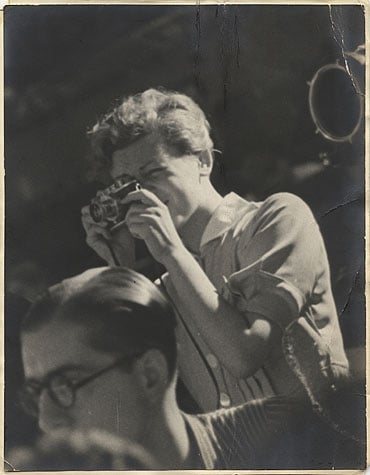Man Finds ‘Deathbed Photo’ of War Photographer Gerda Taro
![]()
A man sharing a photograph of his father online has apparently stumbled upon the last known photograph of legendary war photographer Gerda Taro, who’s regarded as the first female to shoot on the front lines of conflict (as well as the first to die while doing so).
It all started on January 16th, when former soldier and historian John Kiszely of Gloucestershire, England, posted a photo of his father to Twitter.
Just dug out this photo of a young doctor with the International Brigade in the Spanish Civil War in 1937 – my father. pic.twitter.com/QY02OAcYOP
— John Kiszely (@johnkiszely) January 16, 2018
![]()
Someone then responded to the Tweet by asking that Kiszely post a photo of the back of the print. Kiszely obliged.
Back of picture. @soniamoll @improbable @jcastrillon76 @mcgoffio pic.twitter.com/YelkH65jIk
— John Kiszely (@johnkiszely) January 18, 2018
![]()
A sharp-eyed observer then pointed out that the wounded woman may be Taro. Kiszely then confirmed that the note on the back of the picture reads: “Mrs Frank Capa, Brunete.”
John, I think the lady is Gerda Taro, the partner of the legendary photographer Robert Capa. She died of injuries when her car collided with a tank on the way back from the Battle of Brunete on 26 July 1937. Does that make sense?
— War Talks at PCL (@barne065) January 16, 2018
Yes. On the back of the photo is written `Mrs Frank Capa, Brunete`. Good detective work!
— John Kiszely (@johnkiszely) January 16, 2018
Wow, what a provenance that photo has!
— Dr Matthew Ford (@warmatters) January 17, 2018
The full inscription reads: “Brunete Front, June 1937 (in Torrelodones) Mrs Frank Capa = of Ce Soire of Paris, killed at Brunete.”
Taro was never married to Capa — she rejected his marriage proposal — but many people mistakenly believed that they were married. The name “Frank” may have been due to a mixup between the names “Robert Capa” and “Frank Capra,” the famous film director.
Gerda Taro, whose real name was Gerta Pohorylle, was the companion and professional partner of Robert Capa (born Endre Friedmann) who helped create the legend of Robert Capa before being killed at the age of 26 while covering the Spanish Civil War in 1937. While documenting the Republican army retreat at the Battle of Brunete on July 25th, Taro was critically injured when the car she was riding on collided with a tank. She died the next day.

“I never looked at the back,” Kiszely tells The Guardian. “To me this was just a photograph of my father with another patient.”
“My very first impression is that it does look very like Gerda Taro,” Taro biographer Jane Rogoyska tells The Guardian. “The thing that inclines one to think it is Gerda Taro is the short hair and those very thin eyebrows, and just the fragility of the body.”
Rogoyska does note that there needs to be additional research into the details surrounding this photo to be sure that it does indeed show the last months of one of history’s most famous war photographers.
Image credits: Photographs provided to PetaPixel by John Kiszely